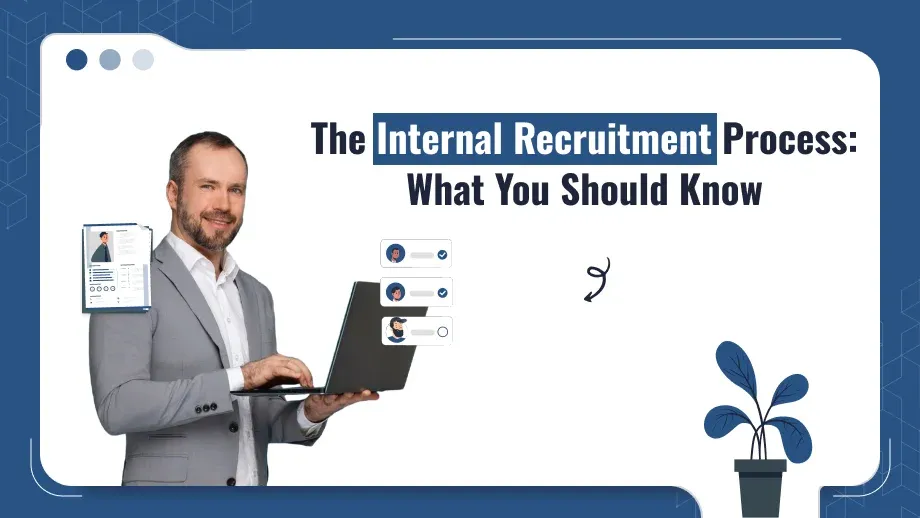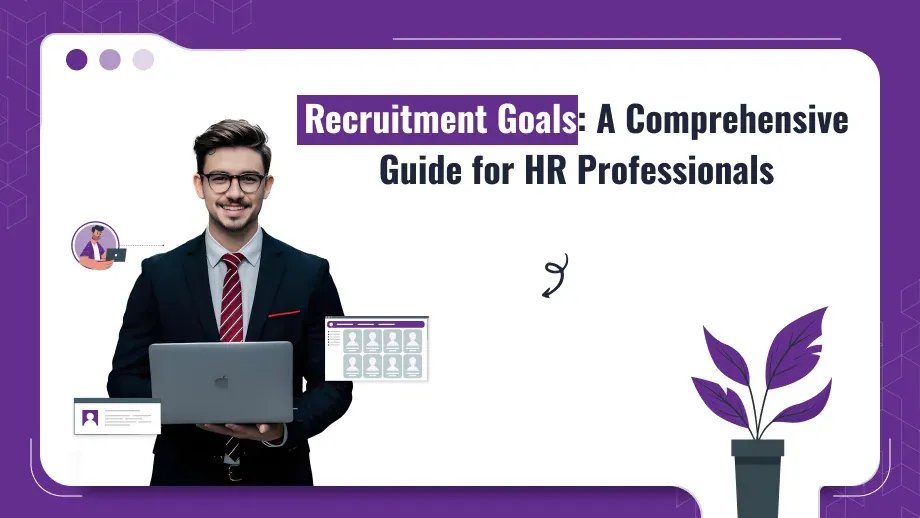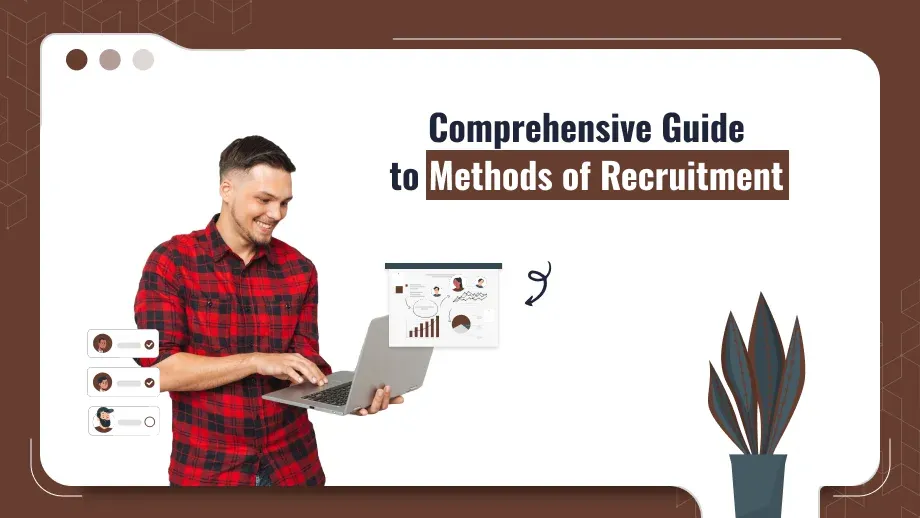
One of the significant objectives of any organization anticipating long-term stability is hiring the right talent. Among the most efficient means to achieve this objective is internal recruitment. The method involves replacing employees internally, hence reducing the costs associated with recruitment, accelerating hiring processes, and ensuring better employee retention. Internal leverages a company’s existing talent pool; it brings growth opportunities to existing employees, and at the same time, new roles are taken by people already in tune with the organizational culture and values.
In this guide, we look at the process of internal recruitment, methods used, advantages, practical steps taken to perform it, common challenges found in internal hiring, and strategies for overcoming them.
What is Internal Recruitment?
Internal recruitment is the process of filling a vacancy by making identification and selection of appropriate candidates from the organization. In contrast to external hiring, which goes out to bring talent from outside, internal recruitment leverages those people already on the payroll. These are people who know the culture and values, as well as the operations of the organization, which makes them great candidates for promotion or internal lateral movement.
Some of the common internal sources of recruitment involve promotions, lateral transfers, job postings, and employee referrals. Internal recruitment allows an organization to create a more cohesive workforce while saving time, cost, and effort for traditional sources of hiring.
How to Recruit Candidates Internally
But for the full benefits of internal hiring, it’s fundamental to systematically carry out the process. Here’s an easy, step-by-step recruitment guide for the internal process:
- Identify Suitable Roles for Internal Hiring
Start with identifying what kind of jobs can be taken by the internal candidates, according to the skills, knowledge, and competencies required.
- Announce Internal Opportunities
Advertisements for the open roles can be done internally through emails, newsletters, or posting through the intranet. Be very specific on the job description, job responsibilities, and the qualifications required so that the employees know what to expect.
- Encourage Employee Applications and Referrals
Establish a culture that encourages inside applicants and encourages them to take their friends along as possible hopefuls to fill the post. This can be achieved by introducing greater mobility within the organization and keeping the application process simple.
- Conduct Fair and Objective Evaluations
- A structured process of assessment should be applied. In this regard, some tools can better help a firm in organizing applications, keeping track of progress, and cross-checking candidate suitability against specified criteria, such as Applicant Tracking Systems (ATS).
- Provide Support for Transitions
Once picked, the internal candidate should be adequately prepared through the provision of training, resources, and mentorship to adapt to their new position. It is in helping the internal hires settle that there is a greater possibility that they will thrive for a longer period in the new position.
Key Advantages of Internal Recruitment
Reduced Hiring Costs
A source of talent that saves on all costs associated with advertising, sourcing, and onboarding is sourcing from within. There will be no job ads or sites that link those who are looking for jobs to those seeking employees in the case of internal recruitment. It will also not include the possibility of expensive relocation for the new employee.
Faster Hiring Process
Internal hires take less processing time since they already are part of the company. This quickens the recruitment timeline since background checks and onboarding processes are streamlined.
Boosted Employee Morale and Engagement
Employees are motivated and engaged when they have opportunities to make their way upward in an organization. The advantages of insider Internal recruitment advantages include creating a culture of growth and improving job satisfaction.
Shortened Onboarding and Training Time
This internal candidate is already knowledgeable about the company’s systems, values, and processes. Thus, it will not take them much time to get on their feet. That means they get up to speed sooner, step into their new roles with ease, and contribute sooner.
Improved Retention Rates
Internal promotion/transfer within the organization shows that the company has regard for its employees and encourages career development. For that reason, employees are less likely to move out of the organization, thereby enhancing retention rates and ensuring stability in an organization.
Methods of Internal Recruitment
Promotions
Promotions are one of the most common methods of internal recruitment. This involves advancing the employee to a higher position with increased responsibilities and compensation. Promotions will recognize employees’ performance and skills and also their potential to give growth within the company to help improve their morale.
Transfers
A transfer takes an employee to a different department or location within the organization but maintains a similar level of responsibility. Transfers are useful in situations where an employee’s skills could be more effectively utilized in a better performing role, or it is otherwise needed to balance team resources across departments.
Job Postings
Internal job postings are submitting the openings at places like an intranet, newsletters, or emails so that workers interested in the position can send in their applications directly. Thus, applications from only those interested in working with the firm are submitted; no inequality occurs among applicants.
Employee Referrals for Internal Roles
Internal referrals could encourage most current employees to act as referral resources in identifying the right candidates for filling up the roles. Employees usually know their peers’ strengths and potential thus providing effective means of finding the right candidates within the organization.
Temporary-to-Permanent Transfers
Sometimes, employees are initially placed in temporary roles to assess their suitability for the position. If they perform well, they may be offered the role permanently. This method allows both the employee and the employer to evaluate fit before committing to a permanent move.
Cross-Training and Lateral Moves
Cross-training employees in other roles and responsibilities can prepare them for lateral moves across departments. A lateral move is having employees assume other positions at the same level in other areas thus expanding the knowledge and experience while keeping them valued within the organization.
Project-Based Assignments
Employees are sent on short-term projects with other departments to demonstrate their skills and fit in new areas. Such employees, who perform well, can be groomed for permanent positions within the department. Project-based assignments offer the employees hands-on experiences in the new roles before a transfer or promotion is made.
Internal Talent Pools and Succession Planning
Many organizations build a talent pool of high-potential employees ready to move into important roles when key positions occur. Succession planning is an organization’s way of identifying some of its employees who may eventually fill leadership or specialized roles.
Skill and Leadership Development Programs
Internal recruitment often draws on employees who participate in skill development and leadership training programs. These programs prepare employees for future roles by providing them with relevant skills and experiences, making them suitable candidates for advancement when roles open up.
Internal Internship Programs
Some companies offer internal internships; that is, employees can serve in a given department or position temporarily as an experience-builder. Employees can explore areas within the organization, and those who do well in their areas of interest are absorbed into permanent roles.
Reassignment for Skill Development
Some employees are transferred to other different departments or roles to expand their skills and abilities. This transfer favors both the employee and the organization because it expands the skills that may be needed for different functions in the future while allowing the employees to pursue varied career paths.
Talent Matching Through Internal Databases
This would match employees within the organization according to their skills, experience, or career aspirations with suitable roles. Again, internal recruitment database allow companies to use an employee database that helps in ascertaining the needs of the organization as candidates with requirements already in place can shine in new roles.
The Internal Recruitment Process: Step-by-Step Guide
Steps form part of the internal recruitment process to ensure that the best candidate within the firm is selected:
- Identify Key Roles and Opportunities
In this first step, identify which roles will need internal hiring and which employees should occupy those positions.
- Define Selection Criteria and Skills Needed
Outline qualifications, skills, and competencies required of a candidate. These all give clear cues to the appropriate candidates to be recruited.
- Communicate Opportunities Across Teams
Use internal channels to promote open roles and encourage qualified employees to apply. This transparency helps avoid misunderstandings and ensures that all interested employees are aware of the available opportunities.
- Evaluate Internal Candidates FairlyEnsure equality in hiring through standardized tests or interviews. Use some of the Recruitment technology tools such as ATS and talent management software to make your application process more standardized while keeping all the applicants under the same yardstick.
- Support Employee Transitions
Resource, training, and mentoring would help the internal candidate make a successful transition into the role. In addition, promoting a culture of openness and positive attitudes concerning work can prepare people within the organization to face future opportunities that can lead them to higher career development.
Make the most of your potential!
Boost your internal recruitment strategy to fill roles quickly and promote team growth.
Challenges in Internal Recruitment and How to Overcome Them
Although internal recruitment offers a host of advantages, it does bring in its share of problems. Overexclusivity in internal recruitment alone may cause limits and other unintended consequences, especially when the skills needed are particularly sharp or fresh perspectives are expected. Considering these possible limitations and solving them with an overall balanced approach where appropriate strategies include more external recruitment would be the surest way for organizations to maximize the benefits that come with hiring from within without compromising the long run and staying there.
The following are some of the common internal recruitment challenges with effective solutions to counter them:
Limited Talent Pool
One of the major challenges with internal recruitment, therefore, is the pool of candidates usually available, which may limit the variety of skills and experience brought to a role. It is more challenging when highly specialized skills are required or when a position demands the availability of fresh and innovative ideas that may not exist within the current workforce.
Solution: To overcome the constraints of a limited talent pool, firms could use internal recruitment methods coupled with external recruitment. The point is that in balancing their efforts, companies get something very useful from internal recruitment, where candidates already know the internal culture and inner functions, and from external recruitment, where candidates bring fresh points of view and new, diverse skill sets. With this strategy, the teams would be balanced and the company and the teams competitive with a dynamic workforce.
Potential for Bias
Internal recruiting sometimes raises bias concerns because, at times, managers and team leaders will have some favoritism and even personal relationships due to which they may end up choosing the wrong individual. This way favoritism or unconscious bias becomes responsible for poor selection that reflects unequitable selections leading to harming team morale and lowering overall productivity in the group.
Solution: Eradication of bias Internal recruitment requires the elimination of bias in the process and through objective selection criteria. Institute an evaluation procedure that evaluates potential candidates concerning ascertainable skills, qualifications, and performance measures consistent with the role requirements. Multiple decision-makers or a diverse selection panel also help eradicate the factor of maximum favoritism when there are different perspectives, which would bring more balanced and just results. This would be reflected not only in internal recruitment but also in internal recruitment and external recruitment.
Employee Resentment
Overlooked for promotion or transfer, employees are resentful of this, and subsequently affects the moods of colleagues, especially when they do not feel that the process of the internal recruitment process is transparent or when selection criteria are not well spelled out.
Solution: Transparency can help employees be less resentful of the process. Open and communicate clear expectations for specific roles, so that an employee who does not get the job will know exactly what is missing. Positive coaching on areas for improvement can prepare an employee for new opportunities. A transparent process in internal recruitment will ensure a better understanding of the procedure by both the employee and, consequently, motivation to further develop professionally and in their careers within the organization.
Skill Stagnation
If only internal sources were considered for recruitment, eventually there would be no diversity of skills and experience, which could eventually hinder innovation. Such a lack of new ideas and skills brought into teams from external recruitment may stagnate the teams’ ability to innovate with changing needs in the industry.
Solution: To prevent skill stagnation, organizations should invest in regular training and development programs. Upskilling and reskilling programs help internal employees expand their capabilities, keeping them versatile and ready for changing roles. Additionally, integrating external recruitment with internal recruitment brings in fresh talent to complement existing teams. This balanced approach promotes continuous learning while ensuring that the organization has access to the latest industry skills and perspectives.
Potential for Limited Diversity
This type of internal recruitment reduces the ability to diversify in teams, as all these employees share the same experience and comparative backgrounds. It will create a homogeneous work atmosphere, which could then limit creativity and innovation.
Solution: Balancing internal recruitment with external recruitment allows companies to take people from diverse backgrounds, experiences, and viewpoints under their umbrella. Diversity through external recruitment at work enables the creation of a rich teamwork environment as well as creativity and effective conflict resolution. Proper use of a balance between internal and external hiring fosters dynamic teams that are diverse, inclusive, and capable of facing ever-changing business issues.
Overlooking Qualified External Candidates
A strong priority on internal recruitment may inadvertently allow the organization to miss out on worthwhile candidates who are externally well-qualified and could bring very valuable skills to the team. While internal growth should always be promoted, an overemphasis on internal hiring may leave out a ready pool of talents existing outside of an organization.
Solution: Maintain a dual focus by using internal recruitment to fill roles where existing employees are well-suited and experienced, and leverage external recruitment for roles requiring specialized skills or fresh perspectives. Periodically review the company’s talent needs to determine which approach will most benefit each role. This combination allows the organization to fill positions strategically, drawing from both internal and external sources to meet specific needs.
Tools and Resources for Effective Internal Recruitment
Technology can make an internal recruit much easier, more efficient, and faster in tracking, assessment, and communication. Which include the following:
- Applicant Tracking Systems (ATS): Solutions within ATS assist with internal job postings, the tracking of applications, and managing interviews.
- Recruitment Database A central repository of employee data that provides ease of identification of potential internal candidates.
- Recruitment Metrics: Important metrics that indicate the effectiveness of internal recruitment are time-to-fill, retention rates, and so on.
These tools allow organizations to build a more data-driven approach to internal recruitment, thus improving its overall efficiency and effectiveness.
Internal vs. External Recruitment: When to Use Each Approach
While internal recruitment has many advantages, there are times when external hiring may be more beneficial. Here’s a comparison:
- Internal Recruitment: Ideal for roles where existing employees possess the necessary skills and experience. It boosts morale and maintains continuity within teams.
- External Recruitment: Useful when specific skills or fresh perspectives are needed. External hires can introduce new ideas and bring diverse experiences to the organization.
In fact, the balancing between internal and external recruitment helps to create a talent pipeline that boosts both the short- and long-term needs of an organization. Recruitment in HR, therefore, has significant implications for steering organizations towards appropriate approaches at any stage of hiring.
Building a Culture that Supports Internal Recruitment
A supportive culture is essential for the success of internal recruitment. Here are some ways to build a culture that values internal mobility:
- Career Aspirations: Encouraging Open Communication Managers should share their open career aspirations with the employees and train them for the potential internal opportunities.
- Provisions for learning and development programs: focused on continuous training to prepare employees for future role assignments while keeping their current skills in touch with what is happening in the market.
- Identify Internal Mobility: You can identify employees who move up within the company that you can use as role models to encourage others to move along the same paths of development.
Creating an internal recruitment culture helps develop value for it, so employees begin to feel valued and are motivated to invest time inside the organization in growing their capabilities.
Conclusion
Internal recruitment, therefore, is not about filling up the number of vacancies available, but rather about strategic building using internal talents to ensure that a workforce becomes resilient. More skills are developed and nurtured from within companies, thereby helping reduce recruitment costs, improve employee engagement, and cultivate a growth-and-opportunity culture. In this way, combining internal recruitment with occasional external recruitment becomes an all-powerful tool for organizations towards stability and growth. Leveraging digital tools like recruitment databases, recruitment metrics, and HRMS Payroll Software in India further enhances this process, streamlining internal mobility and tracking employee performance. These tools make internal recruitment an integral part of a strong workforce strategy, ensuring that businesses can adapt and thrive.





